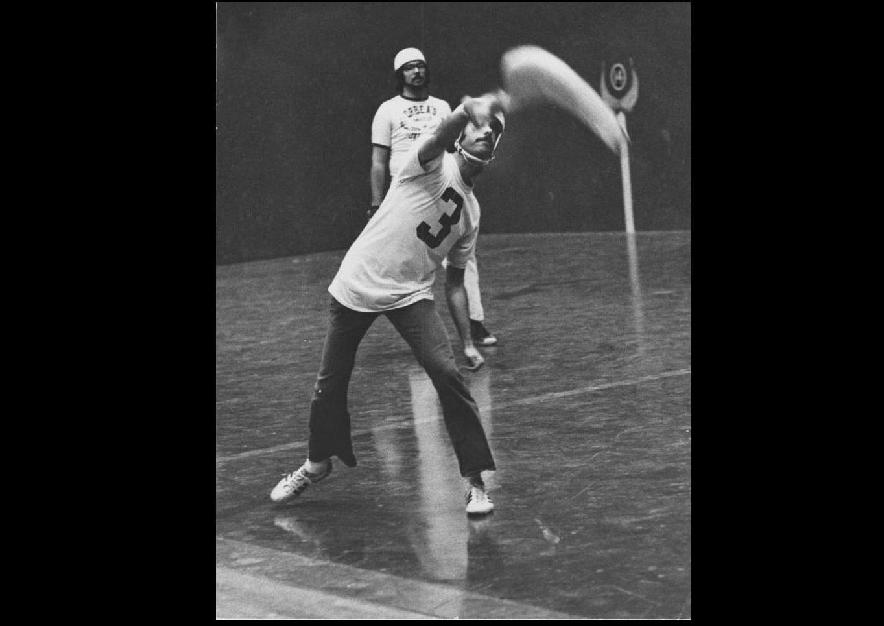Bachelor of Science Degree in Jai-alai Part 2 (3 of 91)

Part 2
A strange feeling was coming over me, my stomach began churning, anxiety and
excitement flooded through my body. We were approaching Daytona Beach, having
driven through Florida’s heartland… Palatka, Hastings, then Daytona.
Those that have had the unique experience of ever playing the sport of Jai-Alai definitely
remember the first time walking on the actual “cancha” or court. It was 8 am, the
mysterious rear door of the player’s entrance slowly opened. An elderly Basque
gentleman, with a look that resembled someone that had not moved his bowels in a
month, impatiently waved us in.
Luis was Daytona’s ball maker. He would allow the amateurs to play various mornings
and give them practice pelotas. He never smiled. He never talked, but to utter some
Basque expletive at the “pakete” amateurs. Heaven help the poor guy who had to go to
Luis for another ball when the cover tore.
I walked through the player’s quarters, my precious “Ernie Larsen” cesta in hand, and
approached the entrance to the court. The local amateurs that were in line in front of me
rushed out to practice first. Only 4 were allowed on the court at one time. There was no
a/c, no lights. The court was illuminated by the rising sunlight through some side
windows.
Finally, it was my turn! I still remember that feeling, in awe of this enormous, 176 foot
long, 50 foot high behemoth of a court. The granite front wall, this huge side wall, the
ball sounding like a rifle shot each time it hit.
I realized that the wall was almost 60 yards away, more than half the length of a football
field. Looking to my right was the wire screen, separating the empty arena of about
3,000 seats. I imagined a full house watching me make by debut, but the only ones in the
auditorium now were the janitors picking up all the losing tickets off the floor.
Now, remember, I had only played on a court less than half this size… and with a rubber
ball. So, this was it, the real thing… I was ready, or so I thought.
Hesitatingly, I walked onto the court, stopping in the rear area. This was the “backcourt”
position. I didn’t choose this, my cesta did. Larsen had given me a backcourt cesta,
which is larger and heavier than the frontcourt baskets. Backcourters are usually the
physically larger and stronger athletes because they have to hurl the pelota a longer
distance. But, I should definitely have been in the frontcourt, since I tipped the scales at
about 140 lbs.
With no warm up or practice, I awaited the serve. “Nick” Nickerson, the top amateur and
hardest throwing amateur at Daytona Beach served the ball. My frontcourt partner let it
come to me. Thinking it would bounce like the rubber ball at Miami Amateur, I started
running toward the ball to make my first catch and return.
Suddenly, within a split second, it was coming directly at my head. I hit the deck and the
ball flew past untouched. I quickly found out the goat-skinned covered pelota not only
bounced but skidded at an enormous speed (pelotas have been clocked at over 170 mph).
This was nothing like rubber ball. The other amateurs grumbled knowing this was going
to be a long morning.
Later I made my first catch and throw. I think there might have even been a volley or
two where I caught 2 consecutive balls. There was no feeling like it, not from any sport I
had ever played.
The few hours passed like seconds. The feeling of accomplishment, when making a
catch and hitting the front wall on a throw, increased geometrically. But, it was time to
return to Gainesville.
College no longer seemed important. Food, sleep, or girls were no longer important. The
most important thing in my life now was to get back on a Jai-Alai court and play again.
Maybe I had, indeed, found my new career.
But, how could I have known that a University of Tampa Sports Information Director,
someone I had never met, would first crush my dreams and then make them a reality?










